Girondins de Bordeaux took on OGC Nice in this past Sunday’s early Ligue 1 kick-off. Both teams were coming into this game off the back of a loss in their previous league fixture and just one point separated the two teams on the Ligue 1 table after four games.
Neither side managed to gain any ground on the other in Sunday’s game, as this clash resulted in a 0-0 draw and in this tactical analysis piece, we will take a look at how both of these teams set up in terms of their tactics for this clash.
We will look at the tactics that both of these two teams used both in and out of possession in Sunday’s fixture and we will discuss some of the key aspects to both of their respective tactical plans, how they ultimately cancelled each other out and how the two teams ended up sharing the spoils in this tactical analysis.
Lineups and formations
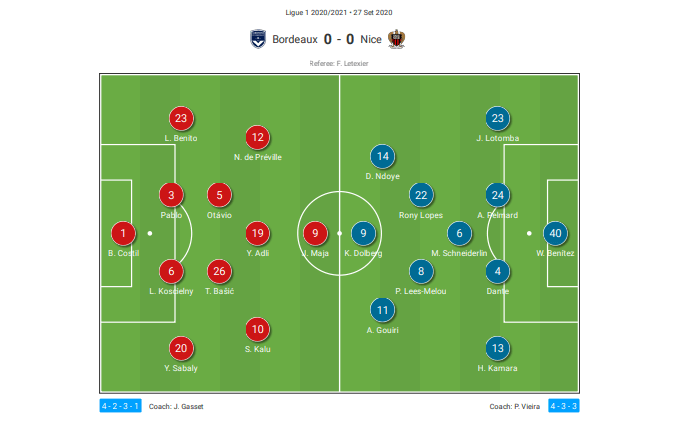
We’re first going to take a quick look at how both sides lined up for this one.
Firstly, we’ll take a look at the home side, who lined up in a 4-2-3-1 shape for this contest. Benoît Costil started between the sticks for Jean-Louis Gasset’s side here, while a back four consisting of right-back Youssouf Sabaly, left-back Loris Benito and the centre-back pairing of ex-Arsenal man Laurent Koscielny and two-cap Brazil international Pablo started in front of him.
Otávio and AC Milan-linked Toma Bašić started in the holding midfield positions for Bordeaux, while Nicolas de Préville played on the left-wing, Samuel Kalu played on the right-wing and Yacine Adli played in a central position just behind centre-forward Josh Maja.
While Bordeaux’s shape was a 4-2-3-1 out of possession in this game, they usually played with a single pivot in possession, shifting to more of a 4-3-3 shape as Otávio dropped to become his side’s sole holding midfielder and Bašić shifted up to join Adli, with the two more advanced midfielders operating more as two ‘8s’ in possession of the ball.
As for the away side, Patrick Vieira lined his team up in a 4-3-3 shape for this contest. Walter Benítez started in goal for Les Aiglons here, while Jordan Lotomba played at right-back, Hassane Kamara played at left-back and the duo of Dante and Andy Pelmard started at centre-back for Nice in this one.
Ex-Everton man Morgan Schneiderlin anchored the midfield for his side here, while Rony Lopes and Pierre Lees-Melou played just in front of him. Ex-Lyon attacker Amine Gouiri started on the left-wing here, while former FC Lausanne man Dan Ndoye started on the right-wing and former Ajax attacker Kasper Dolberg started in the centre forward position, thus completing Nice’s starting XI for this game.
Bordeaux in possession
Moving onto the tactical analysis portion of this piece, we are first going to take a look at some of the key aspects to Bordeaux’s tactics in possession of the ball in this past Sunday’s Ligue 1 fixture.
Les Girondins ended this game having kept 45% of the possession in the contest. They had the same total number of possessions in this game as Nice had (107) and they reached the opposition’s penalty area with more of them (15) than their opponents did (11).
This indicates that while Bordeaux kept less of the ball than Nice did in this game, they were efficient with their use of possession and their superior 1.54 expected goals (xG) to Nice’s xG of 1.12 also indicates that the home side generated the better goalscoring chances in this one.
Bordeaux were far less patient and careful in possession than Nice were in this game. The away side typically play in quite a possession-based, cautious style and this led to them attempting 85 more passes in total than Bordeaux did here. Additionally, Nice had an average possession duration of 18 seconds, while Bordeaux had an average possession duration of 15 seconds, which further highlights that Nice typically spent more time on the ball than Bordeaux did.
However, Bordeaux still managed to build into the opposition penalty area on more occasions and their less patient and slightly riskier style of play in possession, compared with their opponents, played a large role in ensuring that this was the case.
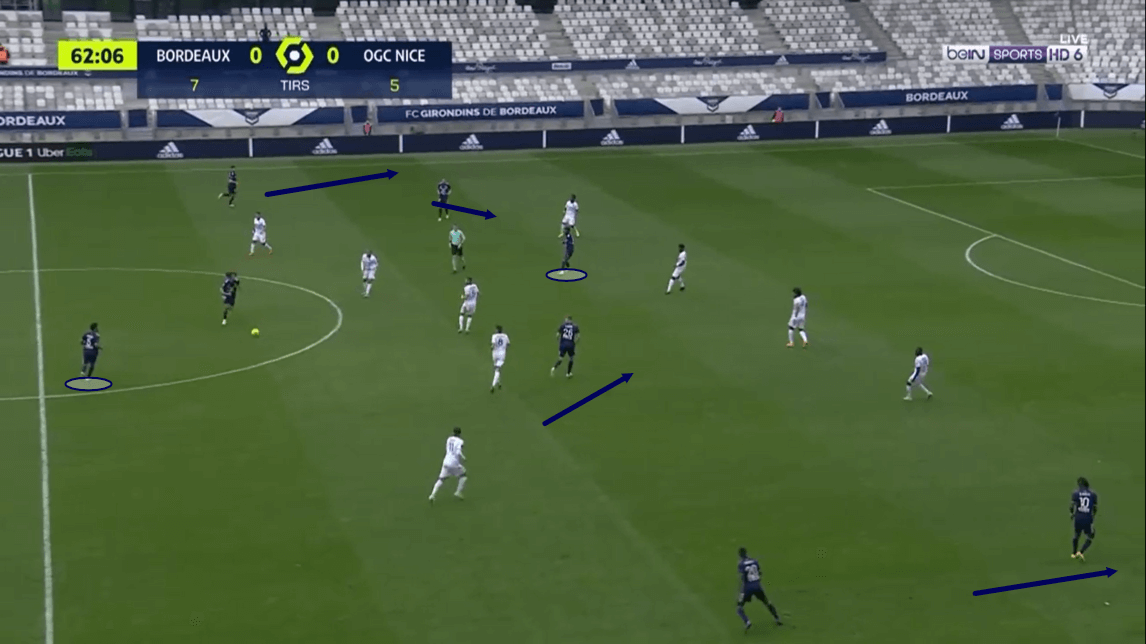
The image above shows us an example of Bordeaux’s shape during an attack from this past Sunday’s game. Here, we can see how Bordeaux’s full-backs both advanced up high on the wing to provide support, however, usually, only one of them would go forward at a time and on this occasion, left-back Benito overlapped, meaning that Sabaly had to sit back and we can see him in the process of shifting back while the left-back advances forward in this image.
Additionally, we can see right-winger Kalu providing width on the right, while left-winger De Préville can be seen shifting inside, opening up space for the overlapping run of Benito in the process.
Meanwhile, Bordeaux’s two ‘8s’ can be seen advancing forward ahead of sitting midfielder Otávio, with Bašić pushing up to join the offensive line here and Adli in possession of the ball, carrying it around the midfield area and trying to pick out the right creative pass. As play moves on, Adli spreads the ball out wide, finding the overlapping run of Benito, on this particular occasion.
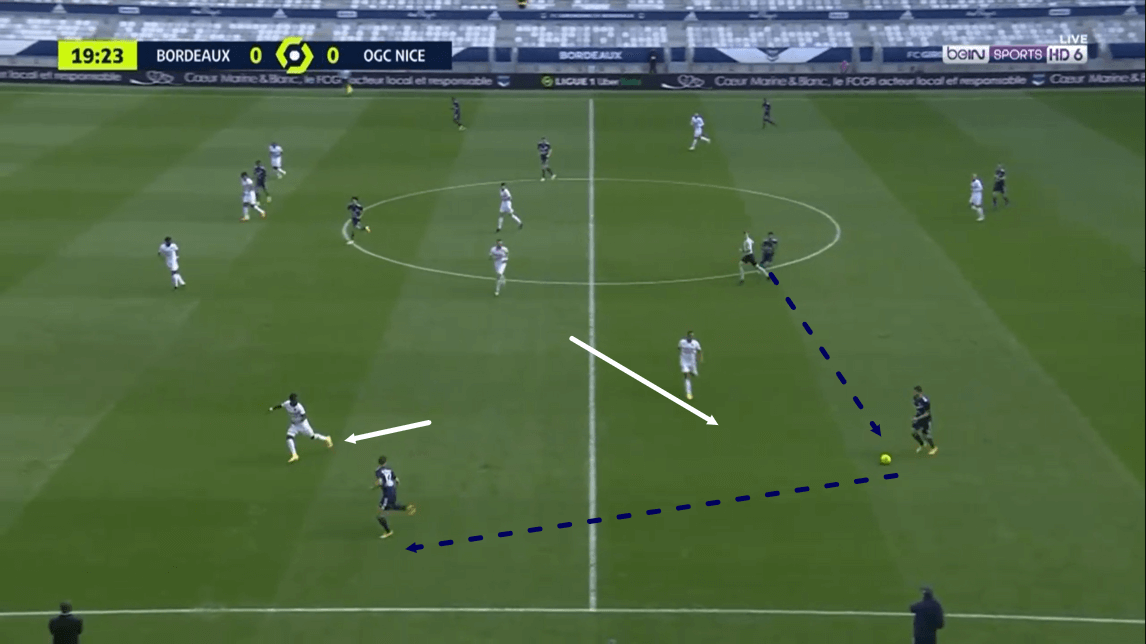
This image shows us an example of how Bordeaux liked to attack via the central areas of the pitch, with their two creative, more advanced midfielders posing a potential creative threat from these areas. However, due to Nice’s defensive tactics, which we will discuss at greater length later on in this tactical analysis piece, the home side were often forced to try and build their attacks via the wings, instead of the centre of the pitch.
The image above provides us with an example of one such occasion when Bordeaux were forced away from the centre of the pitch during the build-up and then had to build their attack via the wing.
Otávio played the ball out to the left-back here and as he received the ball on his stronger left foot, the opposition’s press limited his potential passing options and he ended up sending the ball up to the left-winger, who is positioned even wider than him, here.
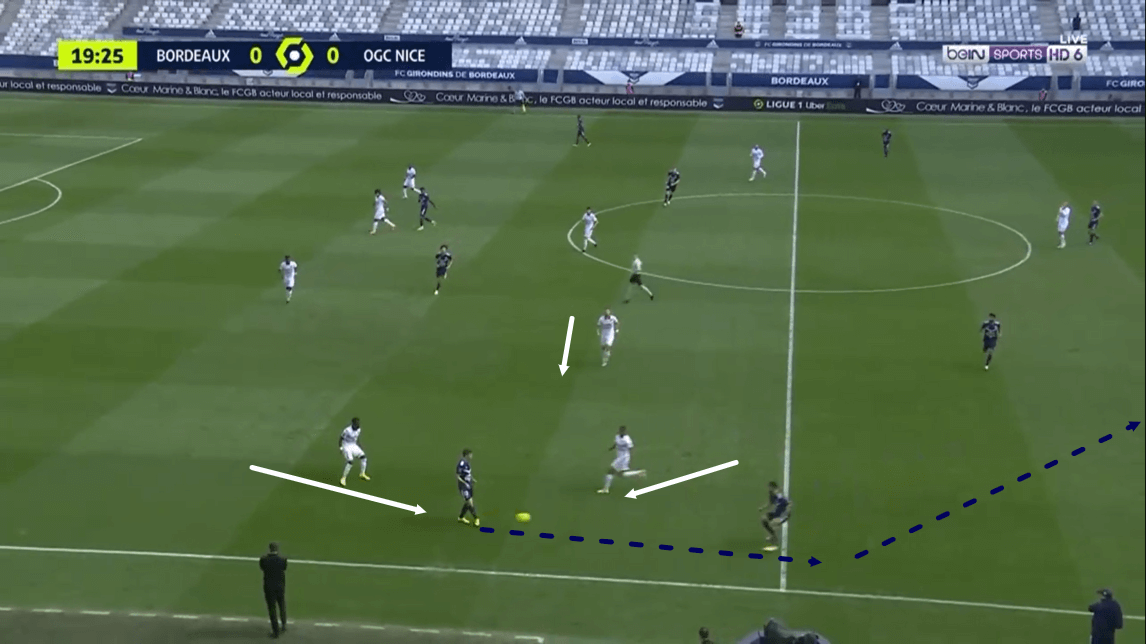
As the winger received the ball, he was quickly closed down by the opposition right-back and right midfielder and with little room either side of him, he was forced to quickly send the ball back to the right-back, who then went on to play the ball back to a central defender.
So, this passage of play provides us with an example of how Bordeaux struggled when trying to build attacks via the wide areas in Sunday’s game. The home side struggled to play through the centre at times due to Nice’s defensive tactics and as they then attempted to progress the ball via the wings, they were often prevented from doing so effectively and were forced to try and re-start their attack from the back.
Bordeaux out of possession
Bordeaux’s ‘passes allowed per defensive action’ (PPDA) statistic was 28.6 for last Sunday’s game, which was significantly higher than Nice’s PPDA of 10.2. This stat backs up that Bordeaux were far less aggressive than Nice with regards to their pressing in this fixture.
However, despite pressing significantly less aggressively, Bordeaux made just 0.03 fewer recoveries per minute (0.41) than Nice made (0.44) in this game. The home side also made 11 more interceptions (56) than the visitors made in this one (45), indicating that successfully making interceptions was a key part of their defensive tactics.
What these stats tell us is that despite pressing much less aggressively than Nice, Bordeaux were efficient in terms of how they used their energy off the ball in this contest and were effective at forcing turnovers.
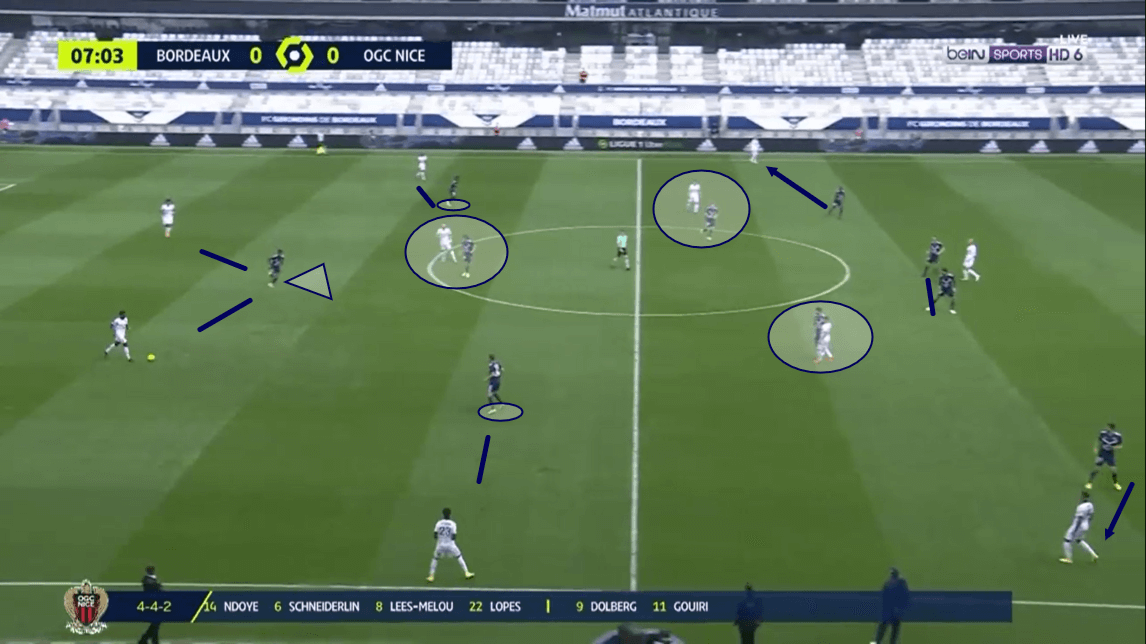
The image above shows us an example of how Bordeaux set up off the ball in this past Sunday’s game. This image shows us their defensive shape and each player’s role within their defensive tactics, which we will explain.
To begin with, as his side’s first line of defence, Maja’s role was to put pressure on Nice’s centre-backs in the early stages of the build-up while also keeping holding midfielder Schneiderlin in his cover shadow.
Bordeaux utilised man-marking to a large extent in this game and all three of their central midfielders – Adli, Otávio and Bašić – were required to man-mark one of Nice’s three midfielders.
Adli’s job was to man-mark Schneiderlin, which was an important job, due to the importance of the former Everton man’s role for Nice in the build-up. Meanwhile, as we can see here, Otávio marked Lopes and Bašić marked Lees-Melou.
Additionally, Bordeaux’s full-backs also man-marked Nice’s wingers tightly, while Les Girondins’ two centre-backs – Koscielny and Pablo – maintained a central position, sticking close to each other and essentially doubling-up on Dolberg in the centre. As for Bordeaux’s wingers, while they maintained access to Nice’s full-backs, they didn’t usually stick as tight to them as other Bordeaux players did, instead of picking up quite a narrow position, making Les Girondins’ defensive shape even more compact in the centre of the pitch and difficult for the opposition to play through.
This man-marking system was effective at stifling Nice’s build-up and preventing them from comfortably playing through their central midfielders in this game. Nice’s centre-backs, Dante and Pelmard, played 82 and 89 passes in this game, respectively, while Nice’s starting midfield trio of Schneiderlin, Lees-Melou and Lopes, between them, played a total of 114 passes, which may indicate just how much Les Aiglons struggled to build-up their attacks from the back through the centre in this one, thanks to Bordeaux’s effective defensive tactics.
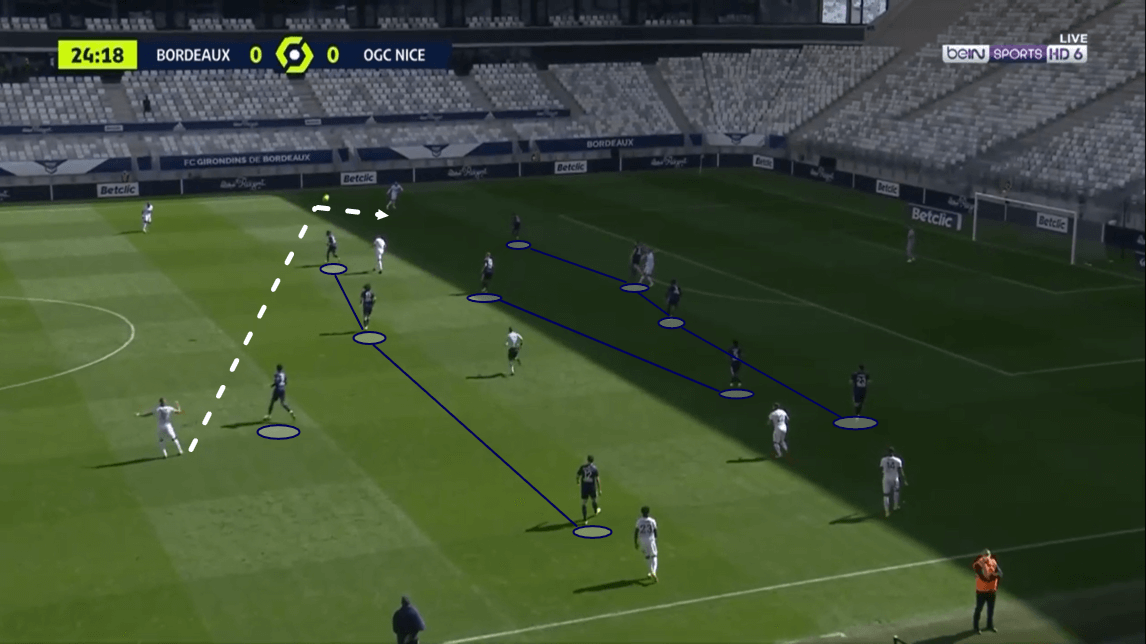
On occasions where Bordeaux had to defend in a deeper area, due to Nice successfully managing to build into their half of the pitch, they dropped into a deep and very compact 4-2-3-1 block and this was also an effective defensive tactic which Nice found tough to break down in this one.
We can see an example of this deep defensive shape in action against Nice in the image above, where we can see the away side playing a cross-field ball to try and find left-winger Gouiri in space out wide and get him in a 1v1 versus Bordeaux’s right-back.
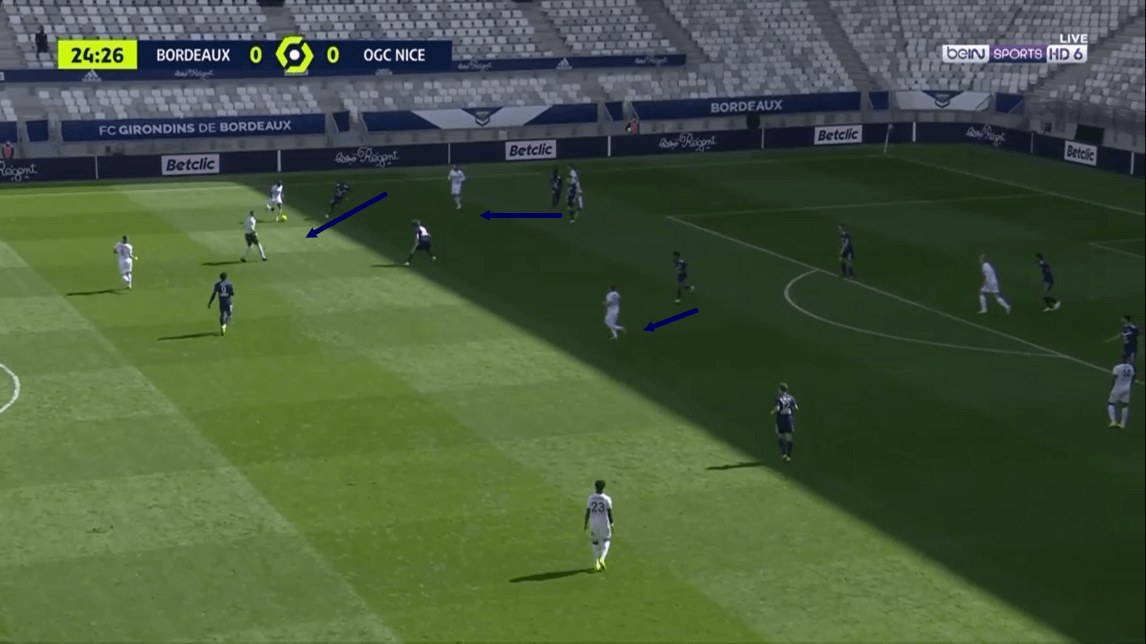
As this passage of play moves on, we see that Gouiri had been forced to play the ball backwards, due to Bordeaux’s players quickly surrounding him and his near passing options and challenging him for the ball.
The ball was played back to left-back Kamara, as we can see here, however, we can also see that Bordeaux winger Kalu is not finished pressing and he actually manages to regain possession for his side via the tackle which follows this effective pressing.
As we explained above, Bordeaux didn’t press very aggressively high up the pitch in this game, as they were happy to drop off and invite pressure to drop into this deeper defensive block which we can see above, however, once the ball progressed to about the mid-way point inside of Bordeaux’s half, which is roughly where it is in this image above, Bordeaux then did increase the intensity of their press dramatically and their organisation and intensity in this deep area of the pitch made them very difficult to break down, while this intensity and the effectiveness of these defensive tactics also helped Les Girondins to create goalscoring opportunities via counterattacks.
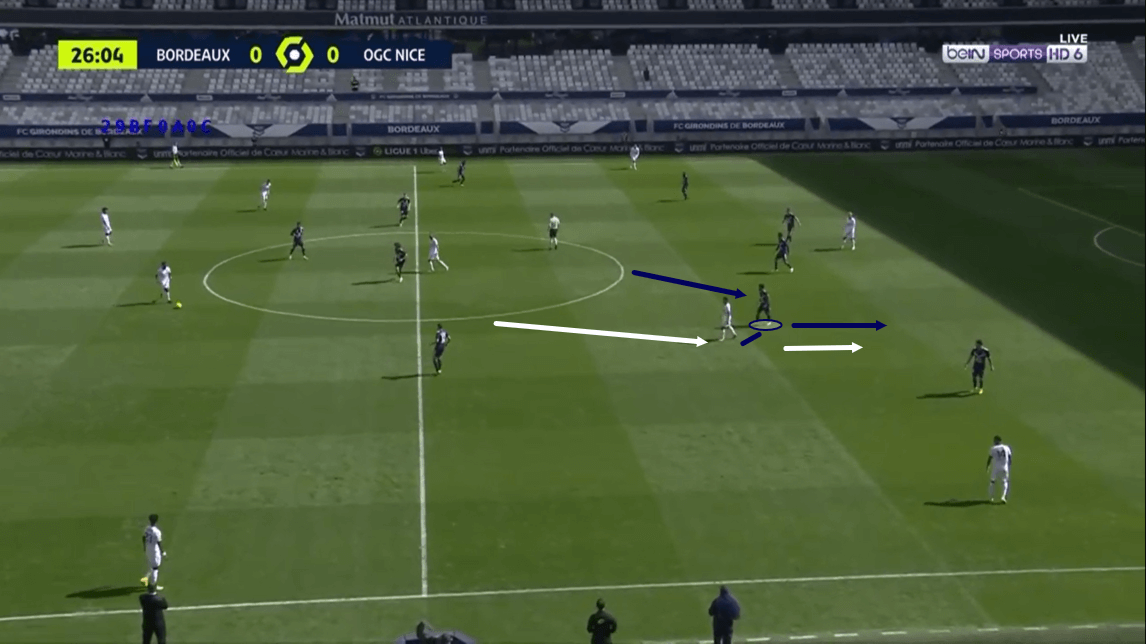
Lastly, while Bordeaux defended in something of a 4-2-3-1 shape, the way in which their holding midfielders man-marked the opposition’s advanced midfielders led to them dropping deeper than usual, almost becoming a third centre-back at times off the ball, which we can see one example of in this image above.
As Bordeaux’s full-backs stayed close to the wingers and their centre-backs stayed very central, keeping tabs on Dolberg, this could create large gaps between Bordeaux’s centre-backs and full-backs which Nice’s advancing central midfielders could then exploit, however, they were unable to do so effectively in this one due to the man-marking job of Bordeaux’s defensive midfielders, who didn’t allow them to roam freely and exploit this space between the full-back and the centre-back, as they essentially plugged this gap via their movement and positioning.
Nice in possession
Moving onto the away side now, and despite ending the game with 55% of the possession, Nice (14) took one less shot than Bordeaux (15) in this game and Vieira’s side only managed to hit the target with two of those attempts, which may indicate that this was, ultimately, a fairly ineffective and inefficient performance from Nice in an attacking sense.
We’ve already touched on the fact that their three starting midfielders made only slightly more passes between them than Pelmard made in this game and now, we will take a closer look at Les Aiglons’ tactics in possession from this game and provide some analysis on the key aspects to those tactics.
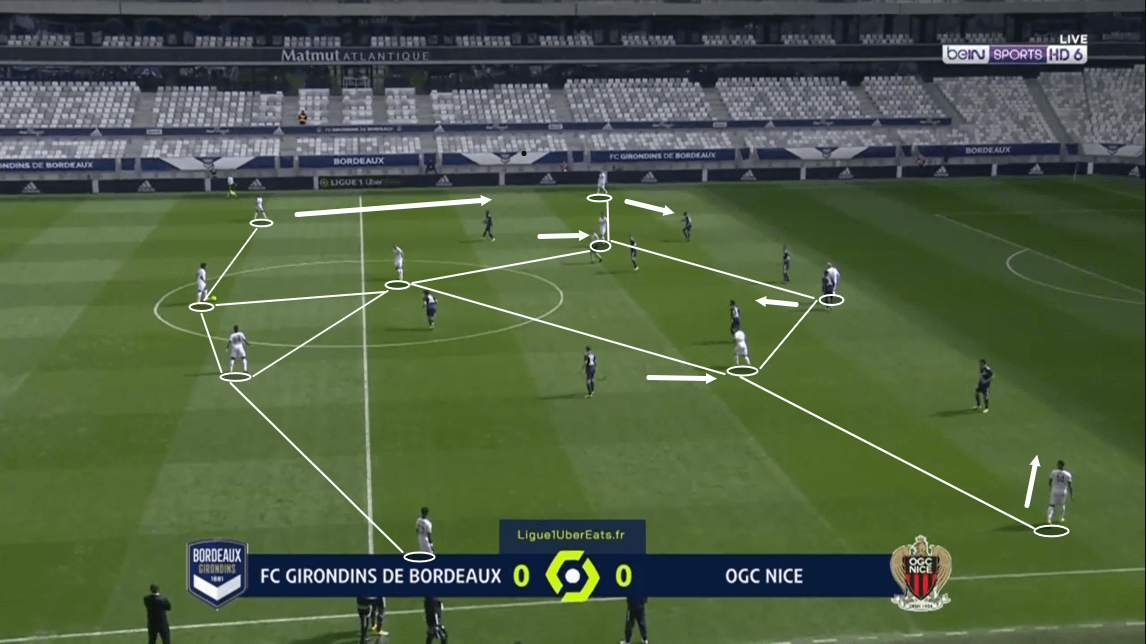
Firstly, this image above provides us with a clear example of Nice’s attacking 4-3-3 shape in this past Sunday’s fixture. Here, we can see their back four in line, with Dante in possession of the ball, during the build-up, while we can also see their front three all in the position one would expect them to be in on paper.
We can also see that both of Nice’s two ‘8s’ are playing in quite advanced positions, just off Dolberg, threatening the space that exists between the Bordeaux full-backs and centre-backs as a result of their defensive tactics, however, they also have the tight marking of the holding midfielders to worry about which made them difficult to find in this one despite their dangerous and intelligent positioning within this offensive shape.
Lastly, we can see Schneiderlin sitting in the holding midfield position, essentially acting as the connector between the backline and this five-man attack consisting of the front three and the two more advanced central midfielders.
One more important aspect to note about Nice’s attacking tactics is the role of the full-backs in this system. Nice’s full-backs, played an important role in the build-up, especially as their central midfielders were often being man-marked and as well as that, Kamara, played an important role in the attack, as his overlapping runs and crossing threat have proven to be an important offensive outlet for Les Aiglons this season and this particular game was no different.
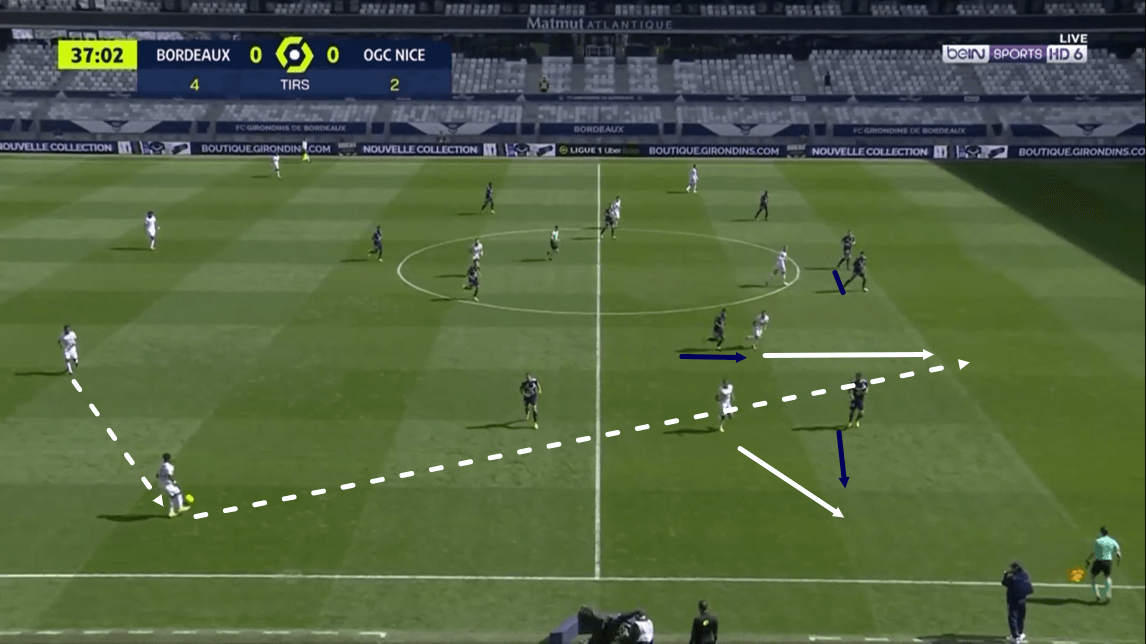
This next image shows us an example of, firstly, how Nice’s full-backs played an important role in their side’s build-up play and secondly, how Nice attempted to exploit the space between Bordeaux’s centre-backs and full-backs via the offensive runs from the advanced central midfielders.
Just prior to this image being taken, Pelmard played the ball out to Lotomba and as the right-back received the ball, Ndoye shifted out wide, dragging the opposition left-back with him.
This created space for Lopes to try and exploit, however, the midfielder was unable to get onto the end of this ball. Regardless, this passage of play does show us an example of one creative way that Nice manipulated Bordeaux’s defence in this game to create opportunities for themselves, but they were ultimately unable to capitalise on these probing runs into this channel between the centre-back and full-back.
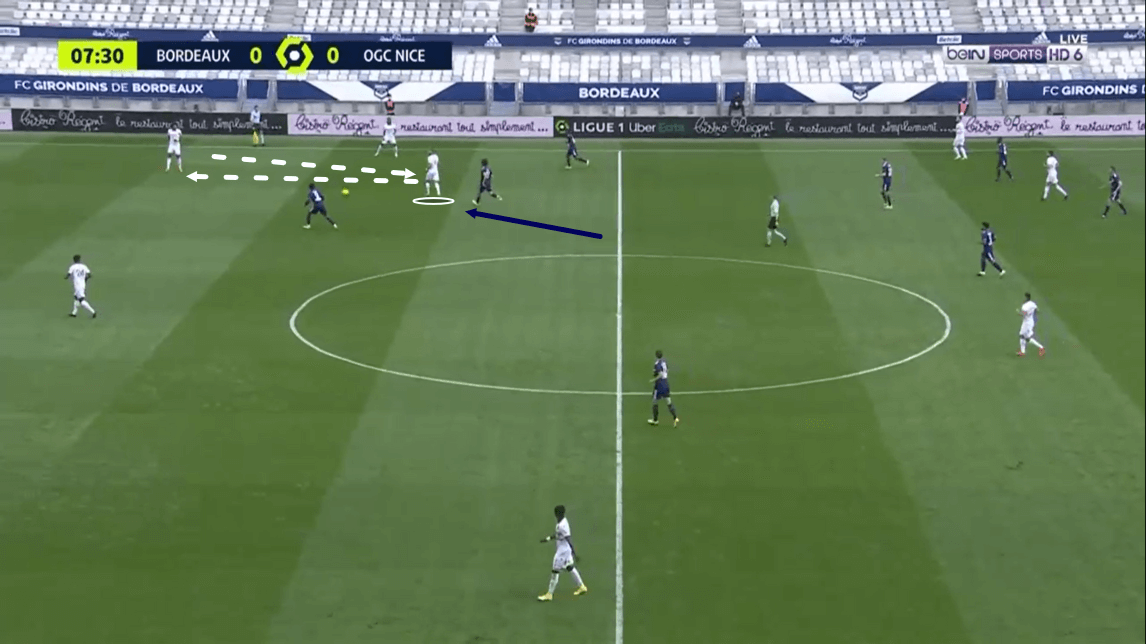
As we already talked about, Adli man-marked Schneiderlin tightly in this game and that made life quite difficult for Nice during the build-up. Just prior to the image above being taken, Nice centre-back Dante had played the ball to Schneiderlin, however, as the French midfielder received the ball, he was quickly closed down by Adli, who remained tight to him throughout this game, and this forced Schneiderlin to play the ball right back to Dante.
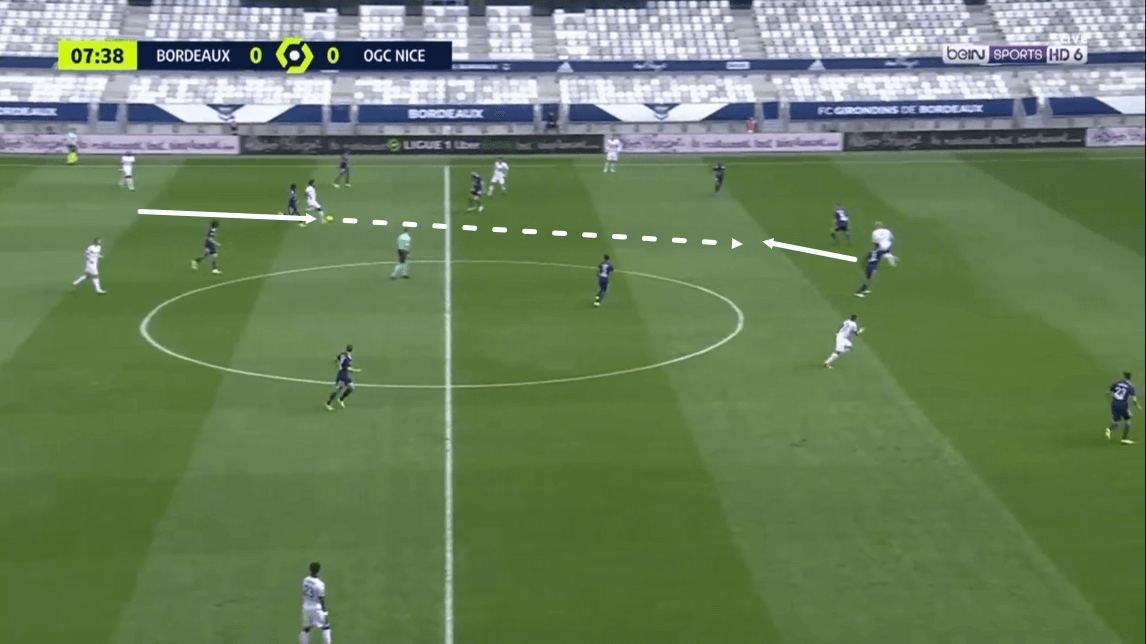
As this passage of play moves on, we see an example of one way in which Les Aiglons attempted to solve the problems caused by each of their three central midfielders, and in particular Schneiderlin, being man-marked tightly during the build-up, making it more difficult for them to build through the centre, and that was for the centre-backs to simply carry the ball into the midfield themselves, bypassing the central midfielders and forgoing the need to play the ball into the central midfielders to build into the opposition’s half.
As a result of their attempts to build-up through Schneiderlin going nowhere due to Bordeaux’s man-marking system, quite early on in the first half, Dante took it upon himself to create a makeshift double pivot during the build-up to get around Bordeaux’s tight marking and still manage to play through them. Pelmard subsequently joined Dante in fulfilling this role before too long.
As this particular passage of play moves on, centre forward Dolberg performs his usual role in the build-up of dropping in deep to link up with the midfield, or in this case, the defence, in order to collect the ball and advance the attack.
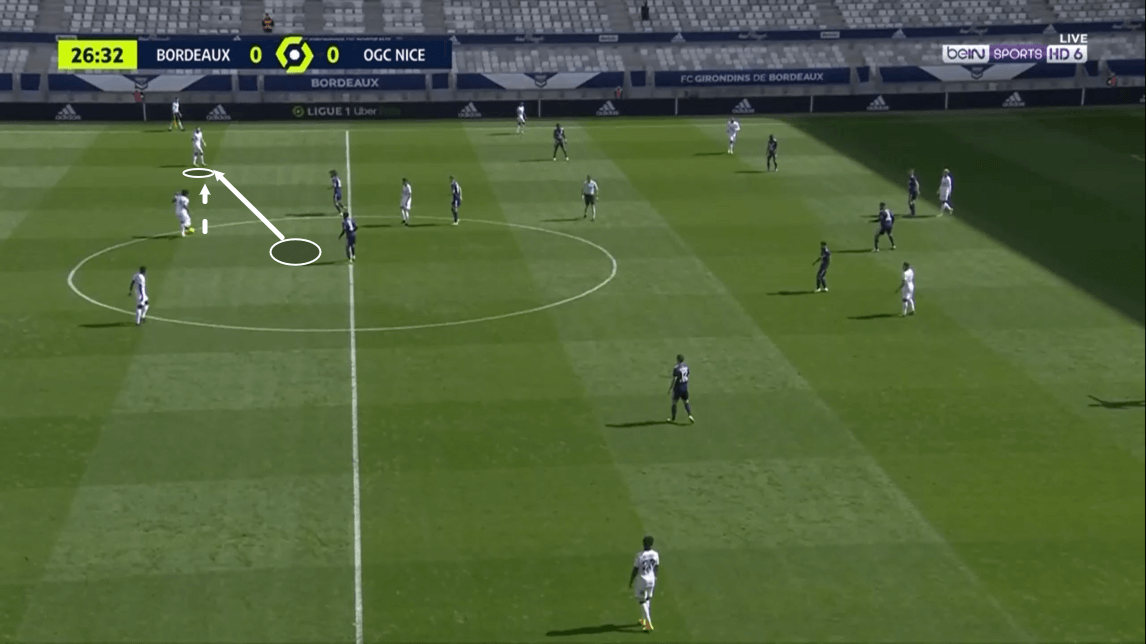
Another way in which Nice attempted to get around Bordeaux’s man-marking during the build-up was for Schneiderlin to drop deep and essentially form a back three alongside Nice’s two centre-backs.
The first couple of times that he did this during the game, he successfully lost Adli and managed to receive the ball with some space, however, Adli did end up following him into these deep positions too before long and this tactic wasn’t the most effective, especially as it still didn’t help to create a great deal of space for Les Aiglons higher up the pitch, resulting in Schneiderlin’s potential passing options being limited despite eventually finding some space for himself.
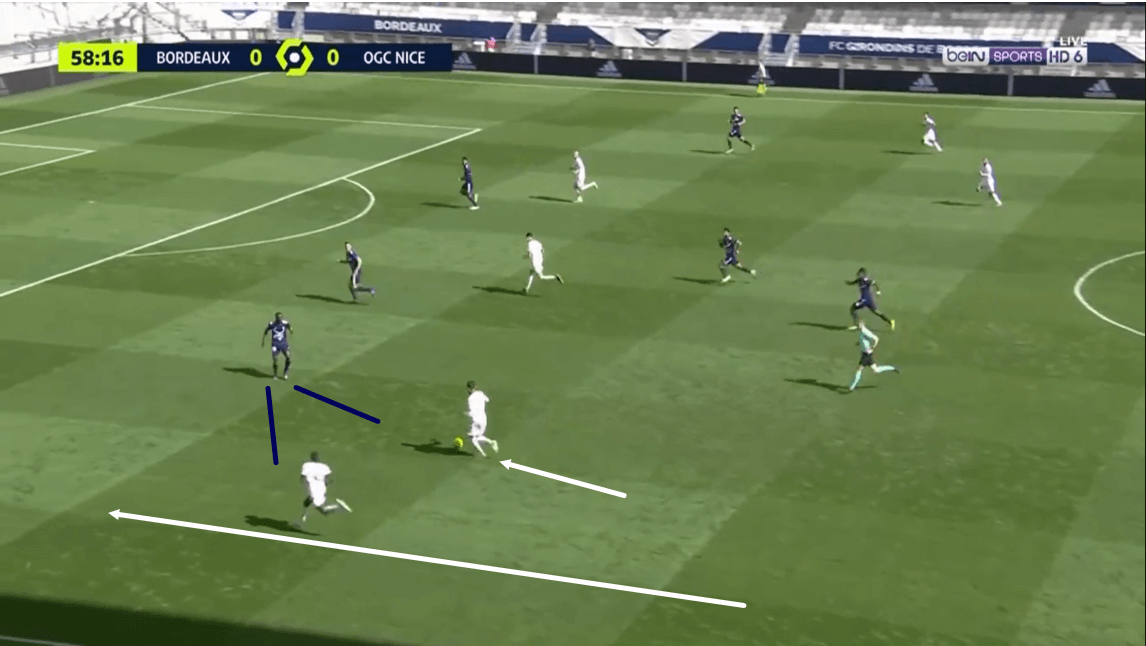
Lastly, this image above shows us an example of the left-wing combination of Gouiri and Kamara in action during this past Sunday’s Ligue 1 clash. Kamara would make overlapping runs on the outside of the young attacker, while Gouiri, a comfortable dribbler, would happily run at the defence and threaten to cut inside onto his favoured right foot.
This combination on the left-wing was a dangerous one for the opposition, firstly, because Kamara provides such a crossing threat from the left-wing on his favoured left foot on the outside, while Gouiri similarly creates problems for the opposition himself when threatening to cut inside and when this combination creates a 2v1 overload versus an opposition full-back, as it did here, it can put Nice in a very advantageous situation and Vieira’s side created multiple quality chances via this combination last Sunday.
Nice out of possession
As is evident by their PPDA of 10.2, which was much lower than their opponent’s PPDA of 28.6 for this game, Nice pressed quite aggressively in this fixture.
A new man constantly pressed the player in possession of the ball high up the pitch and forced them to play the ball either into the holding midfielder, who multiple Nice players would then close in on from different directions in an attempt to dispossess them, or out into the wide areas, where the players could combine with the sideline to make it difficult for Bordeaux to play past their press.
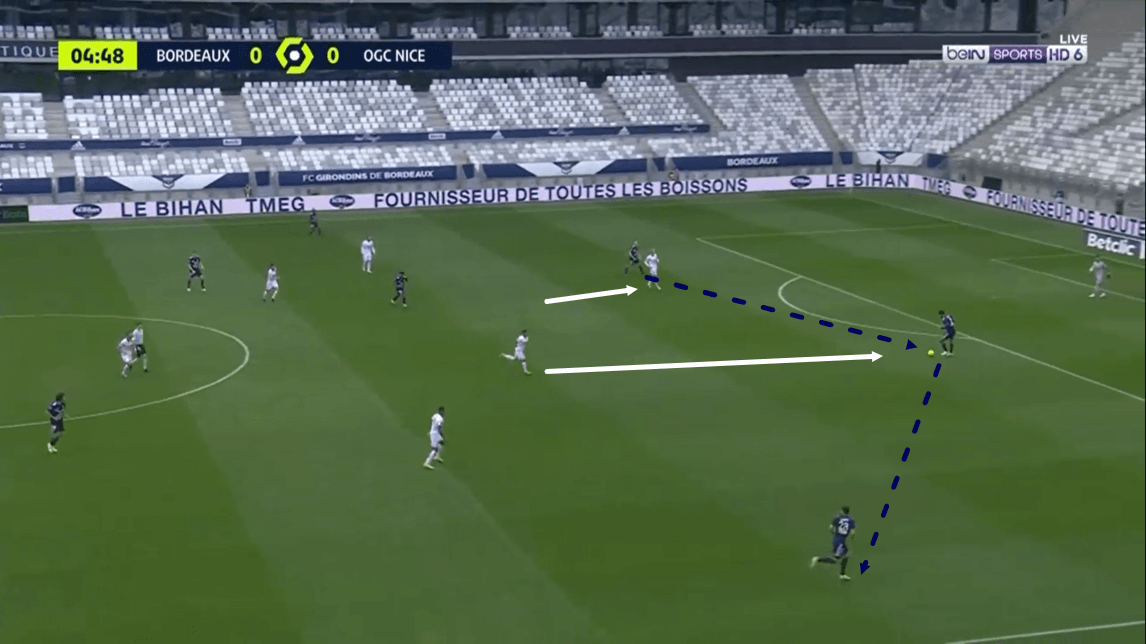
The image above provides us with an example of Nice’s aggressive press in action. Just prior to this image being taken, Dolberg pressed Koscielny, who then played the ball across to his central defensive partner Pablo.
As Pablo received the ball, Dolberg stayed where he is, blocking off the possibility of the defender returning the ball to his central defensive partner Koscielny, and the Brazilian was then the subject of an aggressive press from Lopes, who departed from his base position in central midfield to perform his role out of possession, which was to press aggressively when he was the next man nearest to the new ball-possessor.
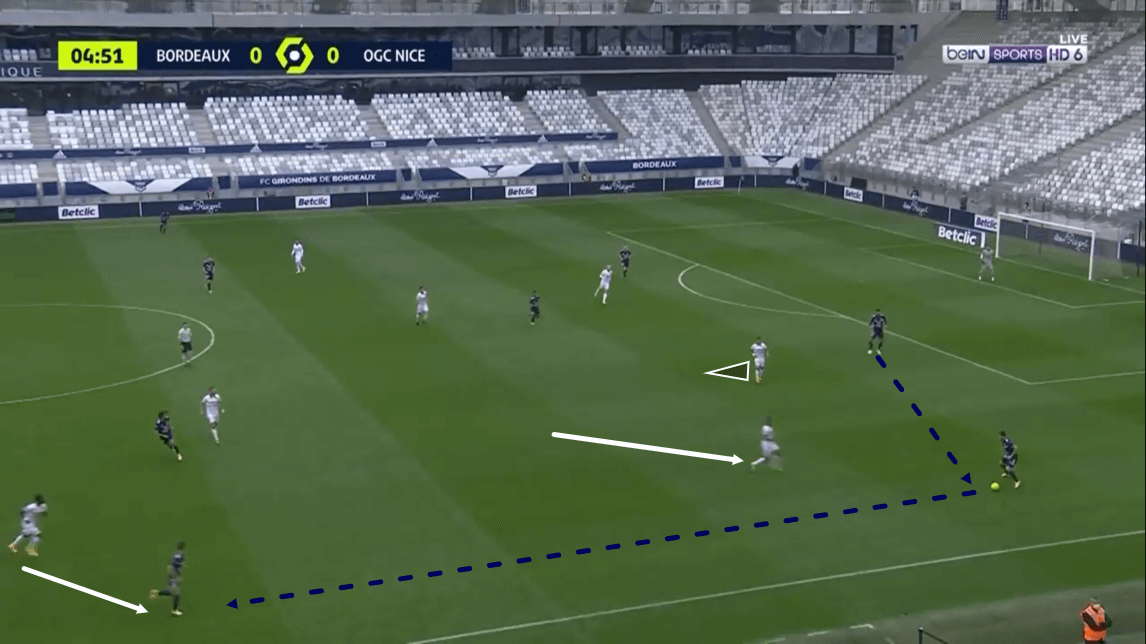
As Lopes closed in on the Bordeaux man, he was forced to play the ball out wide to the left-back and at this point, Nice will have been comfortable with their position and how their pressure was working.
Similar to Dolberg previously, Lopes stayed in his position after the ball was played out to the left-back, maintaining access to Pablo should the ball be played back to him and also keeping holding midfielder Otávio in his cover shadow, as right-winger Ndoye then presses the new ball-possessor, moving out towards him from the centre, discouraging a potential pass from this position into the centre of the pitch.
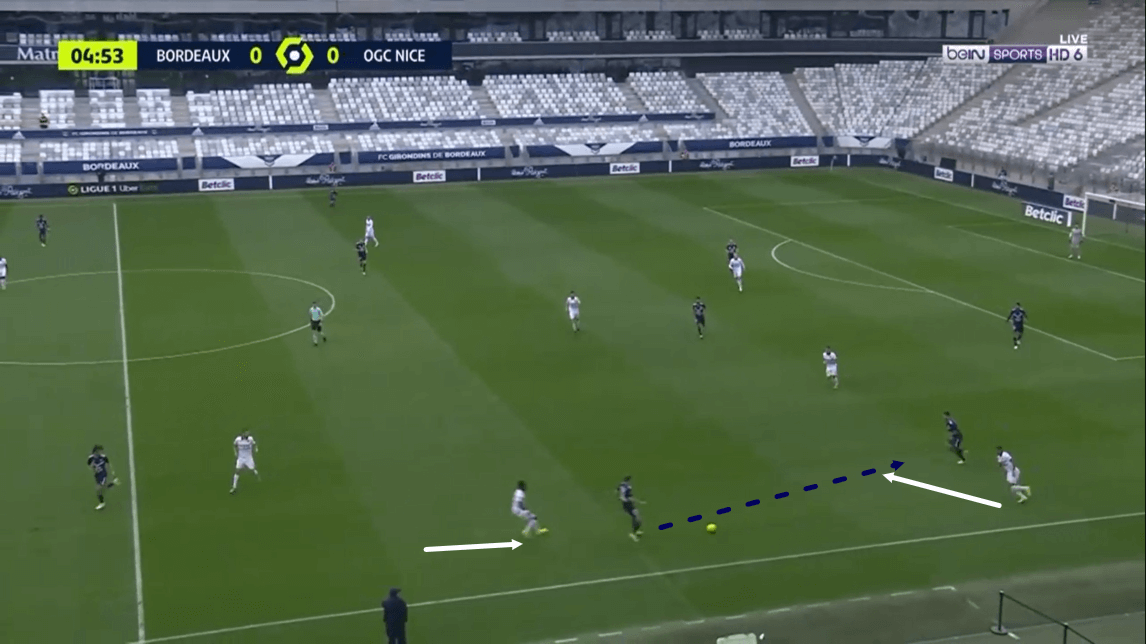
As play moves on, we see that the left-back linked up with the left-winger, however, he was quickly pressed and prevented from turning, resulting in the ball being played straight back to the left-back and before the left-back could carry the ball out of his own half, he was dispossessed finally thanks to this Nice press and Les Aiglons subsequently sprung a quick counterattack from a dangerous position, demonstrating how this type of pressing can be seen as an important offensive tool as well as a defensive tool.
Conclusion
To conclude this tactical analysis piece, it’s clear that both teams had some clear differences in how they set out to play in Sunday’s game, with Nice playing in a more aggressive style off the ball and a more patient style on the ball and with Bordeaux doing the opposite, in a lot of ways.
Bordeaux’s man-marking defensive tactics were effective at nullifying Nice’s threat from the centre, while Nice’s high press was also effective at stifling Bordeaux’s build-up and creating some goalscoring opportunities.
Both sides cancelled out some important aspects to the others’ game quite effectively in this one, which may make it no surprise that this ended in a stalemate.


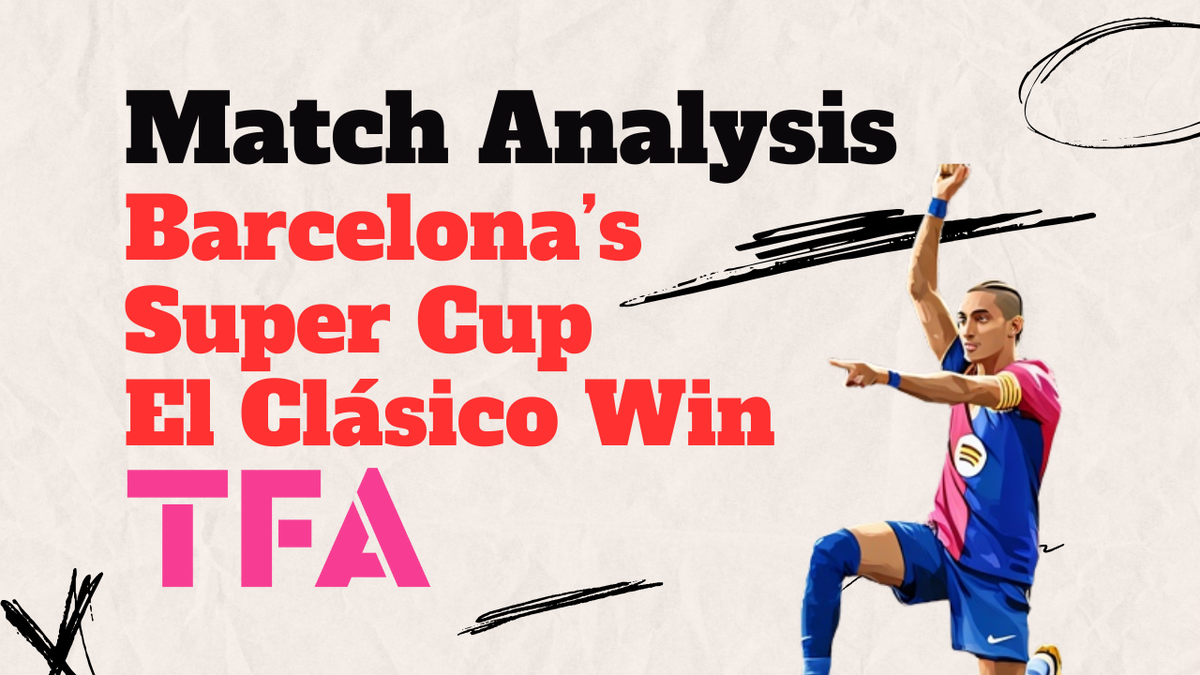
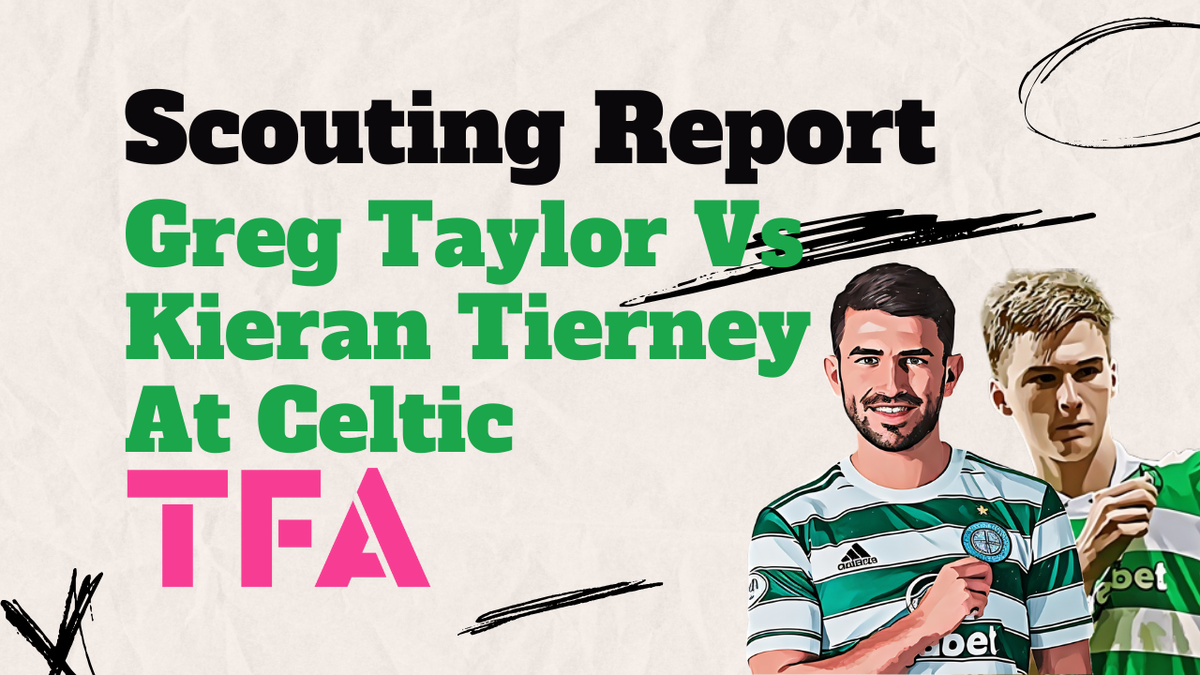
Comments